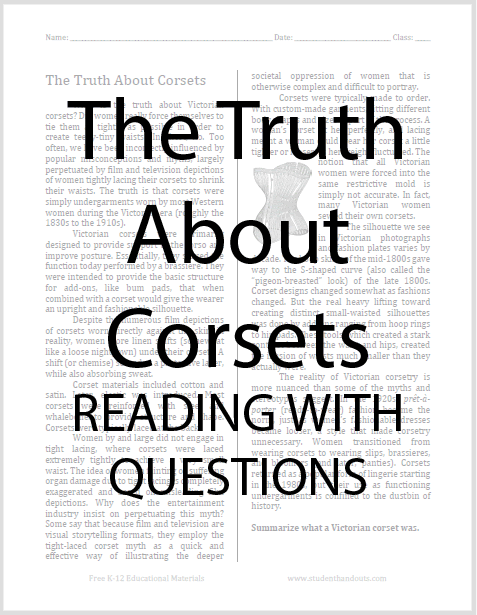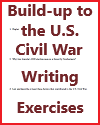| The Truth About Corsets Reading with Questions |
|---|
| www.studenthandouts.com ↣ World History ↣ La Belle Époque ↣ La Belle Époque Miscellany |
 |
    |
|
Click here to print. Answers will vary. What is the truth about Victorian corsets? Did women really force themselves to tie them as tightly as possible in order to create teeny-tiny waists? In short, no. Too often, we have been incorrectly influenced by popular misconceptions and myths, largely perpetuated by film and television depictions of women tightly lacing their corsets to shrink their waists. The truth is that corsets were simply undergarments worn by most Western women during the Victorian era (roughly the 1830s to the 1910s). Victorian corsets were primarily designed to provide support to the torso and improve posture. Essentially, they served the function today performed by a brassiere. They were intended to provide the basic structure for add-ons, like bum pads, that when combined with a corset would give the wearer an upright and fashionable silhouette. Despite the numerous film depictions of corsets worn directly against the skin, in reality, women wore linen shifts (somewhat like a loose nightgown) under their corsets. A shift (or chemise) served as a protective layer, while also absorbing sweat. Corset materials included cotton and satin. Later, elastic was introduced. Most corsets were reinforced with steel and whalebone. to provide structure and shape. Corsets were typically laced at the back. Women by and large did not engage in tight lacing, where corsets were laced extremely tightly to achieve a very small waist. The idea of women fainting or suffering organ damage due to tight lacing is completely exaggerated and based on misleading film depictions. Why does the entertainment industry insist on perpetuating this myth? Some say that because film and television are visual storytelling formats, they employ the tight-laced corset myth as a quick and effective way of illustrating the deeper societal oppression of women that is otherwise complex and difficult to portray. Corsets were typically made to order. With custom-made garments, fitting different body shapes and sizes is part of the process. A woman’s corset fit her perfectly, and lacing meant a woman could wear her corset a little tighter or looser, as her weight fluctuated. The notion that all Victorian women were forced into the same restrictive mold is simply not accurate. In fact, many Victorian women sewed their own corsets. The silhouette we see in Victorian photographs and fashion plates varies by decade. The hoop skirts of the mid-1800s gave way to the S-shaped curve (also called the "pigeon-breasted" look) of the late 1800s. Corset designs changed somewhat as fashions changed. But the real heavy lifting toward creating distinct small-waisted silhouettes was done by add-ons ranging from hoop rings to hip pads. These tools, which created a stark contrast between the waist and hips, created the illusion of waists much smaller than they actually were. The reality of Victorian corsetry is more nuanced than some of the myths and stereotypes suggest. In the 1920s, prêt-à-porter (ready-to-wear) fashion became the norm, just as women's fashionable dresses became looser, a style that made corsetry unnecessary. Women transitioned from wearing corsets to wearing slips, brassieres, and bloomers (and later, panties). Corsets returned as a popular form of lingerie starting in the 1980s, but their use as functioning undergarments is confined to the dustbin of history. |
| La Belle Époque Books and Films | La Belle Époque Maps and Pictures |
| La Belle Époque Outlines and PowerPoints | La Belle Époque Worksheets |
| La Belle Époque Miscellany | La Belle Époque Study Games |
| www.studenthandouts.com ↣ World History ↣ La Belle Époque ↣ La Belle Époque Miscellany |








